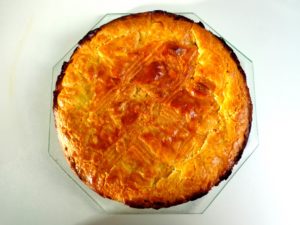
Basque cake
This delightful cake from the French Basque country consists of golden pastry filled with vanilla cream with a hint of rum. Preparation is a bit of a project, but it’s worth the effort, producing a fine dessert for a festive occasion.
Leave yourself plenty of time for making a gâteau basque, as the dough needs to chill for a couple of hours. And although creating the pastry and cream is easy, assembly can be tricky — the dough is fragile, making it a challenge to transfer it into your cake pan.
Why bother, you might ask. Well, unless you live in the Basque country or near a pastry shop that sells this cake (and they’re rare, even in Paris), the only way to taste a gâteau basque is to create it yourself. Just keep a shot of rum handy to steel your nerves.
You will need an 8-inch (20-cm) cake pan, preferably springform, a rolling pin, some parchment paper and a pastry brush. The recipe calls for five eggs in total, and the cake will serve 6-8 people. It goes well with coffee, tea or — why not? — Champagne.
For the dough:
2/3 cup sugar
1 egg plus 1 egg yolk
1 organic lemon
1/3 pound unsalted butter (150 g, 1-1/3 stick), at room temperature
1 tsp. baking powder (levure alsatienne)
1/2 tsp. salt
1-3/4 cup (200 g) flour, plus extra for rolling
For the pastry cream:
2 egg yolks
1/4 cup (50 g) sugar
1 tbsp. rum
1/4 cup (30 g) flour
1 cup (1/4 liter) milk
1/2 tsp. vanilla extract or 1 vanilla bean, halved
1 tsp. unsalted butter
For assembling the cake:
1-2 tsp. extra butter for buttering the cake pan
extra flour for rolling the dough
parchment paper
1 egg
Begin by making the dough.
Measure the sugar into a large bowl. Add the egg yolks. Stir.
Grate the lemon peel finely and add to the bowl. Beat until the color softens to pale yellow.
Cut the softened butter into smallish pieces and add one at a time, mixing constantly until you have a uniform cream.
Add baking powder, salt and about half of the flour. Continue mixing until well blended.
Turn off the beaters, add the rest of the flour and finish the blending with your hands.
Pat the dough into a ball and refrigerate for 2-3 hours.
While the dough is chilling, make the pastry cream.
Combine 2 egg yolks and the sugar in a medium bowl. Stir vigorously until the color softens to pale yellow. Stir in the rum, then the flour.
Heat the milk and vanilla (or a halved vanilla bean) in a saucepan. When the milk boils, pour it into the egg mixture in a slow stream, stirring constantly. (If using a vanilla bean, pour the milk through a strainer.)
Transfer the mixture back to the saucepan. Place over low heat, whisking constantly with a wire whip. As soon as the mixture returns to a boil, turn off the heat.
Place the butter on top of the thickened cream and move it around to coat the surface — this will prevent a skin from forming. Allow to cool to room temperature.
When the dough is thoroughly chilled, assemble the cake.
Preheat the oven to gas mark 6 (350 F, 180 C).
Place your cake pan over a sheet of parchment paper and draw a circle around the circumference. Cut out the circle. Butter the cake pan and line the bottom with the parchment paper. This will make it easier to unmold the cake.
Generously flour a large board and your rolling pin. Cut the chilled dough into two parts: 2/3 and 1/3.
Place the 2/3 portion of dough on the board and flatten it with your hand to make a circle. Turn it over, reflouring underneath. Roll out the dough into a round about 2 inches (5 cm) wider than your cake pan, reflouring as necessary.
Run a spatula under the dough to loosen it from the board. Very gently fold it in half, and then in quarters. Transfer it to your cake pan and unfold. Press the dough out with your fingers so that it evenly covers the bottom and sides of the cake pan. If your pan is very deep, it does not have to go all the way up the sides — 2 inches (5 cm) will suffice.
Spoon in the pastry cream and spread it out with the back of the spoon.
Now repeat the patting and rolling process with the 1/3 portion of the dough. Roll it into a circle just slightly larger than your cake pan.
This time, to transfer it, flour your rolling pin and gently roll the dough up around it, unrolling over the pastry cream. Pinch the edges of the dough together to seal tightly.
Beat the egg. Using a pastry brush, paint the top of the cake to make an egg glaze.
Very gently run the tines of a fork over the surface of the cake to make a criss-cross pattern, as shown in the photo.
Bake for 30 minutes, or until golden.
Allow to cool thoroughly before serving. Serves 6-8.




